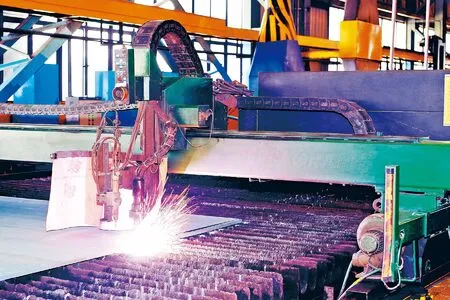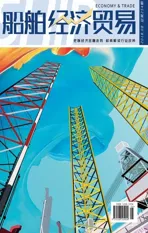“Container+” Model and Intelligent Industrial Revolution
2018-08-28ByZhaoZhijianChenGe
By Zhao Zhijian Chen Ge
Since the first appearance in 1956,through over 60 years, container has become the most important part in the global shipping system. More than 90%types of cargoes in the current world are transported by ship and road via container. For the modern shipping, a highly automatic, low-cost and lowcomplexity freight transport system,the core in the core is container, and one can even say it is benefiting from the container appearance that global industry can today have the development pattern of flattening, decentralization and sharing.


The importance of container lies in that it not only defines normalized cargo transport standard, but also benefiting from the container transport model,global shipping cost is compressed to an extent which is sufficient to change the development trend of the global manufacturing industry, resolutely breaking the shackle of “Bordering economy and local market” and realizing the production model of global integration. For today's global manufacturing industry, container has become so important that its figure has even run through the whole production chain of the product. At the same time,containers have become so fragile that their development depends entirely on the benign expansion of global manufacturing. When world economic growth slowdown has become a new normality of market and decapacity has become the primary goal of each business, how containers and container shipping industry behind it break their own limitation and open up a new situation is a current problem that needs to be solved.
No matter which industry or what kind of model, it will ultimately face the market. As the saying goes, “Cargo is King”, it is “product” that is the most core factor dominating the whole industrial chain. Therefore, the concept of "commercialization of containers"has become very important: Only when contain is not only a cargo carrier,but also one of necessary equipment for commodity production, container transport is no longer a pure logistic means, rather a production process,can container be upgrade to a quasicommodity, thus becoming a factor affecting the market rather than simply being affected by market.
The success of liquid containers and refrigerated containers has shed light, so that broad space for container expansion and upgrading drifts into view. In conjunction with the concept of modular design which has already been applied in the ocean engineering field and smart manufacturing “Internet+”thinking, integrating the structural characteristics of the container itself and the industry characteristics of container transportation, we can try to use the concept of "container+" to discuss and look forward to a new container industry model with container as the matrix and function module as the extension.
At present, there is the rudiment of "container" mode in the market:Refrigerated containers can be seen as a combination of container+ refrigeration modules, while liquid container is a combination of container+ liquid cargo transport modules. Of course, both the refrigerated container and the liquid container have only expanded the types of containers that can be transported,and have not yet reached the level of"container commercialization". The core of the "container+" mode for the purpose of "container commercialization" lies in the fact that the application of "plug and play" "function module" gives the container certain production function. For example, the "dry container" composed of container+microwave steam mixing drying module can well realize highgrade timber transport drying integrated process, in order to substantially improve the drying quality of wood and reduce the rate of waste, it will greatly reduce the increase of the time and economic cost caused by onshore drying, and the additional expenditure caused by customs quarantine procedures. Moreover, it can be used in the drying of grain, fruit and other crops, as well as the production of dried fruit, fruit powder, with a wide range of production functions.
Meanwhile, the production and transportation mode of container combined with forward-looking market judgment can solve the problem of high empty container rate. It is well known that due to the huge difference in import and export demand between China and the United States, liners from the United States have to load a large number of empty containers to maintain the stability of the transport chain. Taking into account many market requirements such as the huge annual vegetable import demand in the Chinese market and the growing demand for organic vegetables from the newly affluent class, and so on, making use of the "intelligent container"temperature and humidity control measures proposed by the logistics industry in the "organic vegetable cultivation" container realized by the combination of container+illumination and moisturizing module can achieve high returns and economic benefits with very small investment and solve the problem of "empty container" at the same time.
Indeed, as the most advanced tool in modern logistics, containers are irreplaceable today, and there is not even a concept of substitution. However,today's containers have kept themselves firmly under the control of the global market while they not only accelerated the turnover of goods around the world, but also accelerated the adjustment of industrial structure around the world. The slump in ocean shipping in recent years is a reminder: As a single means of logistics, container can no longer meet its own development needs.Container industry must gradually complete the “container+” mode transformation, if the container industry is to shoulder off the status of getting rid off market development,and only in this way, can it realize self-breakthrough amidst the vibrant industrial revolution wave and open up a new legendary chapter.★

